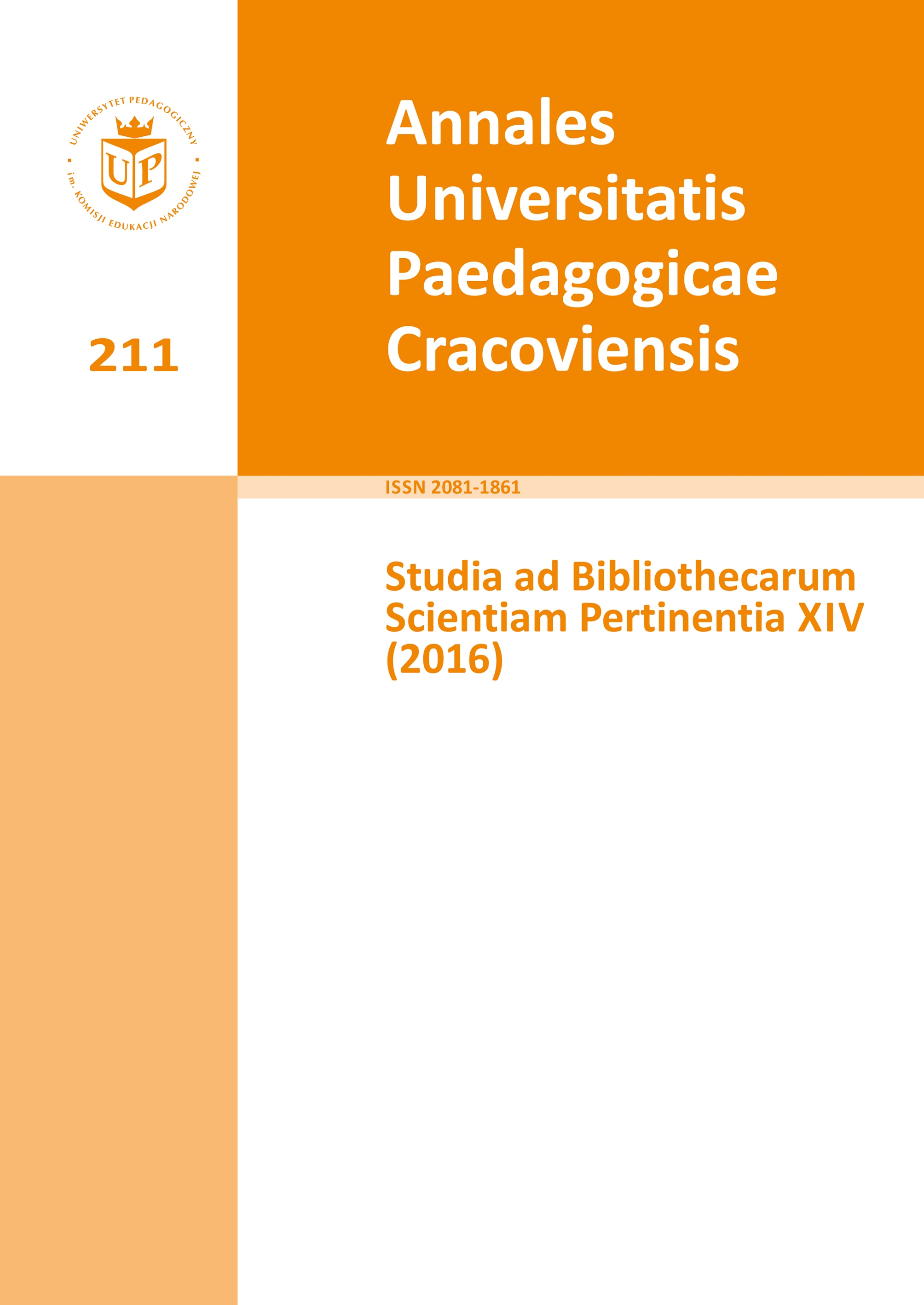Next generation electronic catalogs in Polish libraries. Usability and information architecture
DOI:
https://doi.org/10.24917/20811861.14.1Słowa kluczowe:
electronic catalog of new generation, information architecture, usability, academic libraries in PolandAbstrakt
The latest generation of electronic directories, called the third or next, was founded, among others, as a result of use of principles of usability in the design of websites. To the characteristics of the directories of third generation in technological terms belong: optimization to meet the needs of users, application of metasearch, interconnection of data into one system. Among the features offered by the new OPAC we have: auto-complete, federated search, faceted search, and personalization. In Poland, among the systems that support new functionalities, we can mention: Virtua CHAMO (Main Library of the Pedagogical University of Cracow), KOHA (Main Library of Cracow University of Technology), Primo Exlibris (Main Library of Silesian University of Technology), Summon ProQuest (University Library of Nicolaus Copernicus University in Toruń) and Prolib Integro (Katowice CINiBA). The aim of the article was to compare these systems in the field of applications of modern mechanisms (patterns) of designing the search systems. None of the analyzed retrieval systems contained all available functionalities to facilitate finding information. The least number of functionalities was found in Virtua CHAMO, the most - in the systems of the type of “discovery” (Primo, Summon and Prolib).
Bibliografia
Beaulieu, M., Borgman, Ch.L. (1996), A New Era for OPAC Research: Introduction to Special Topic Issue on Current Research in Online Public Access Systems. ‘Journal of the American Society for Information Science’, 47 (7), pp. 491–492.
Borgman, Ch.L.(1996), Why Are Online Catalogs Still Hard to Use? ‘Journal of the American Society for Information Science’, 47 (7), pp. 493–503.
Chmielewska-Gorczyca, E. (1990), Wyszukiwanie rzeczowe w publicznie dostępnych katalogach online. „Zagadnienia Informacji Naukowej” No. 1, pp. 139–162.
Churchwell, Ch.D. (1975), The Library Academia: An Associate Provost’s View. In: E.J. Josey (Ed.), New Dimensions for Academic Library Service (pp. 21–33). Metuchen, N.J.: The Scarecrow Press, Inc
Cutter, Ch.A. (1904). Rules for a dictionary catalog, by Charles A. Cutter, fourth edition, rewritten. Retrieved from: http://digital.library.unt.edu/ark:/67531/metadc1048/.
Denholm, C. et al. (2009), Making the new OPAC seamless: dealing with the transition from “finding” to “getting”. ‘Library Hi Tech’. Vol. 27, No. 1, pp. 13–29.
Dobrzyńska-Lankosz, E. (2000), The Krakow Project. Problems of Management. In: Library Automation in Transitional Societies. Lessons from Eastern Europe. Ed. by Andrew Lass & Richard E. Quandt. New York: Oxford University Press, 2000, pp. 360–373.
Emanuel, J. (2009) Next Generation Catalogs What Do They Do and Why Should We Care? Reference & User Services Quarterly Accidental Technologist. Ed. by M. K. Kern, Vol. 49, Issue 2, pp. 117–120.
Emanuel, J. (2011), Usability of the VuFind Next-Generation Online Catalog. “Information Technology and Libraries”. March, pp. 44–52.
Fethers, T., Gaul, Ch., Marshall, J.-A., Tiffen, B. (2013), From Search to Discovery in our Future Library. University of Technology Sydney. Retrieved from http://www.lib.uts.edu.au/blog/university-librarian/2013/04/search-to-discovery-our-future-library.
Hildreth, Ch.R. (1982), Public Access Catalogs: The User Interface. Dublin (Ohio): OCLC.
Hofmann, M.A., Yang, S.Q. (2012), “Discovering” what’s changed: a revisit of the OPACs of 260 academic libraries. “Library Hi Tech”, Vol. 30, No. 2, pp. 253–274.
Butterfield, K (2003) Online Public Access Catalogs. In: Encyclopedia of Library and Information Science, Vol 3. 2nd ed. Ed. by M.A. Drake, New York: Marcel Drekker, Inc., pp. 2268–2273.
Kurek-Kokocińska S. (1998), Z zagadnień terminologicznych nauki o informacji. Potrzeba języka słów kluczowych. „Zagadnienia Informacji Naukowej”, No. 2, pp. 76–86.
Macan, B., Fernández, G.V., Stojanovski (2013), Open source solutions for libraries: ABCD vs Koha. “Program: electronic library and information systems”, Vol. 47, No. 2, pp. 136–154.
Merun, T., Zǔmer, M. (2008), New generation of catalogues for the new generation of users. A comparison of six library catalogues. “Program: electronic library and information systems”. Vol. 42, No. 3, pp. 243–261.
Mitev, N.N., Venner, G.M., Walker, S. (1985), Designing an Online Public Access Catalogue: Okapi, a catalogue on a local area network. Library and Information Research Report 39. London: British Library Board.
Mobile online w Polsce 2015. Perspektywy rozwojowe. Raport. (n.d.). Warszawa: IAB. Retrieved September 12, 2016, from http://www.ican.pl/files/book_raport_mobile_2015.pdf.
Morville, P., Callender, J. (2010), Search Patterns. Beijing: O’Reilly.
Online Catalogs: What Users and Librarians Want. An OCLC Report. (2009). Dublin (Ohio): OCLC Online Computer Library Center, Inc. Retrieved from http://www.oclc.org/content/dam/oclc/reports/onlinecatalogs/fullreport.pdf.
Osborne, H.M., Cox, A. (2015), An investigation into the perceptions of academic librarians and students towards next-generation OPACs and their features. “Program: electronic library and information systems. Vol. 49, No. 1, pp. 23–45.
Reitz, J.M. (2004), Dictionary for Library and Information Science. Westport, Connecticut: Libraries Unlimited.
Russel-Rose, T., Tate T. (2013), Designing the search experience. The Information Architecture of Discovery. Amsterdam: Morgan Kaufman.
Sadeh, T. (2013), From search to discovery. Paper presented at: IFLA WLIC 2013 – Singapore - Future Libraries: Infinite Possibilities in Session 98 – Knowledge Management with Academic and Research Libraries. . Retrieved from http://library.ifla.org/id/eprint/104.
Sanetra, K., Gruchała, I. (1995) Katalog online system VTLS. Podręcznik dla bibliotekarza. Kraków: Ed. by Jagiellonian Library.
Swoboda I. (2009), OPAC WWW wizytówka biblioteki. Ocena jakości katalogów komputerowych małych i średnich bibliotek w Polsce. ”Przegląd Biblioteczny” 2009, Vol. 1, pp. 16–40.
Wang, Y., Mi, J. (2012), Searchability and Discoverability of Library Resources: Federated Search and Beyond. “College & Undergraduate Libraries”, 19, pp. 229–245.
Pobrania
Opublikowane
Jak cytować
Numer
Dział
Licencja
Prawa autorskie (c) 2017 AUPC Studia ad Bibliothecarum Scientiam Pertinentia

Utwór dostępny jest na licencji Creative Commons Uznanie autorstwa 4.0 Międzynarodowe.

